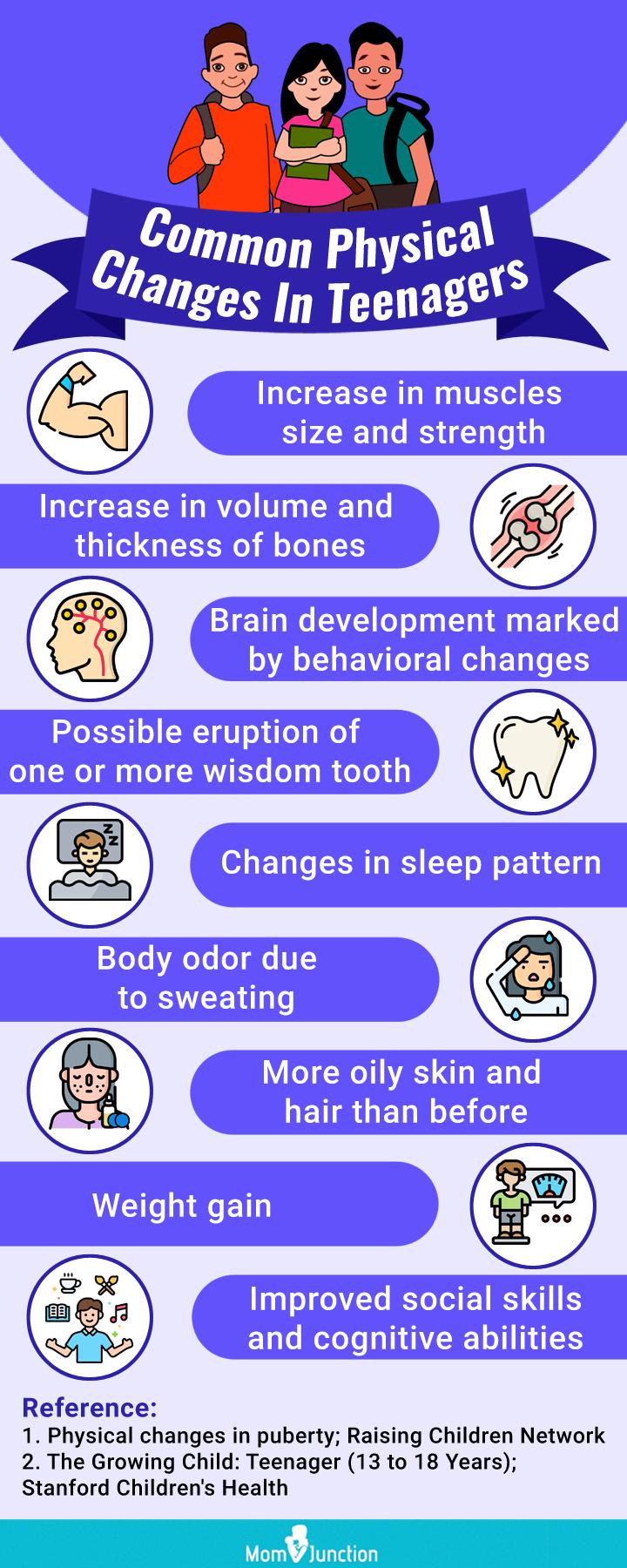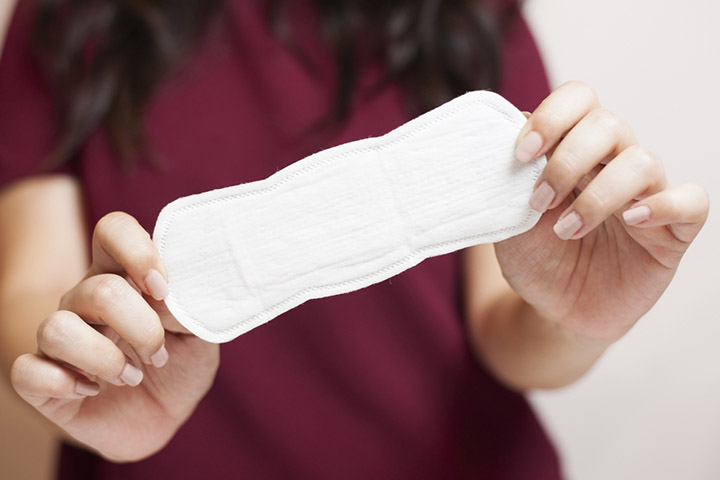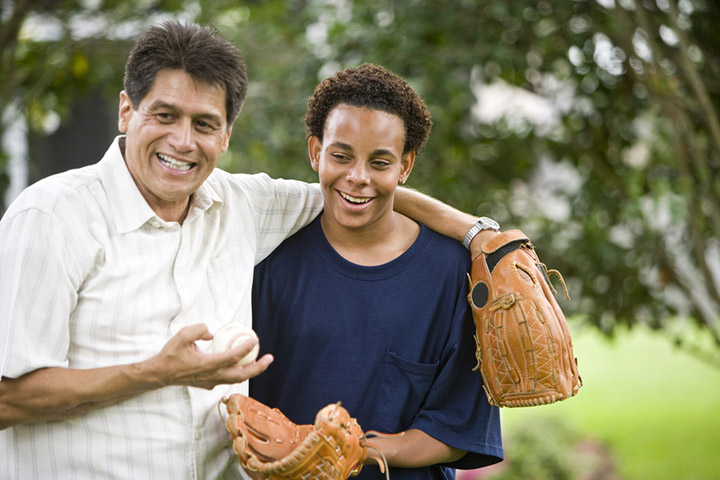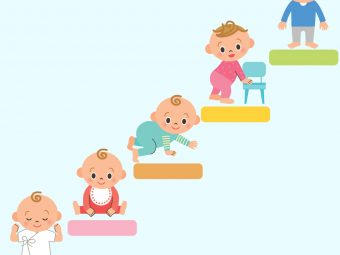
Image: ShutterStock
Physical changes during puberty differ in boys and girls. However, both males and females attain marked physical growth during puberty. This is when a child transitions to adulthood physically, mentally, and emotionally. These changes may begin at different times in each child. Some may have early puberty, while slightly delayed in a few.
Secondary sexual characteristics develop in puberty. For example, girls may begin to menstruate, while boys have mustaches and beards coming in, and their voices deepen. Read on to know more about physical changes in puberty for boys and girls and seek medical care if puberty is delayed.
The growth spurt starts at about 13 years10 Physical Changes During Puberty
Some major changes occur in adolescent boys and girls. During this period, the body starts to develop and grow into physical maturity. This is the time when your body will start developing all the secondary sexual characteristics. Many teens and families are hesitant to discuss body changes. It is important to speak to your child before these changes to know what to expect and reach out to your pediatrician if you have any concerns.
Physical Changes In Girls During Puberty:
The physical changes for females during puberty experience are marked by the following features of growth (1):
- Puberty in girls is marked by the start of the menstruation cycle, commonly referred to as periods.
 Point to consider
Point to considerImage: Shutterstock
- During adolescence, significant physical changes occur, including breast development, which typically reaches full growth by the age of 18 (2).
- Hair growth in the pubic area and the armpits are also observed. The growth of pubic hair may be the first sign of puberty in some girls.
- The adolescent years are also marked by a rapid growth spurt. In girls this growth spurt starts at the age of 11 or usually around the time she reaches menarche and slows down by the age of 16 (3).
 Health fact
Health factPhysical Changes In Boys During Puberty:
The physical changes during puberty for males that occur are different in a number of ways. The developments that a boy undergoes during adolescence are (4):
- In boys, the scrotum and the testicles start to grow when they reach puberty.
- The penis also increases in length and reaches the proper adult size and shape by the age of 17 or 18 (5).
- Facial hair, as well as hair growth in the pubis area, armpits, and chest, have been observed. This usually starts around the age of 12; by the time the boy reaches 18 years, the pattern of body hair growth resembles those of adults.
- The growth spurt starts at about 13 years and continues on to about 18 years of age. After that, the growth slows down (3).
Image: Shutterstock
- Adolescent boys commonly experience voice changes as a part of their physical transformation. Their vocal cords grow and as a result, the voice pitch changes into a heavier tone.
 Did you know?
Did you know?How To Help An Adolescent To Cope With The Changes?
Here are some points to keep in mind as your adolescent goes through these changes (4) (5):
- It is important to remember that though the physical development in adolescence is rapid, the mental faculties are still in the developmental stage.
- With adolescence comes a whole new range of emotions, a new found sense of responsibility and freedom, and a lot of physical changes. The child is sometimes unable to keep pace with all the changes occurring in its body.
- Most times, adolescents distance themselves from their parents and tend to resort to their peer group for answers. It is at this point that you as the parent need to step forward and be a friend and guide to your child.
Image: Shutterstock
- Make sure that your child is well-informed about all the physical changes they have to experience during adolescence.
The physical changes during puberty in males and females can be overwhelming at times. Significant developments, such as hair growth in private areas, deepening voice in males, menstruation in females, may be confusing and quite a lot to take in. Therefore, this phase is when they need your utmost attention as their parents. Talk them through this phase, or better yet, it may be more beneficial to educate them beforehand and prepare them for changes they may experience as they proceed towards adulthood.
Infographic: Common Physical Changes In Boys And Girls During Puberty
Both boys and girls experience physical changes during puberty other than developing secondary sexual characteristics. Check out the below infographic to know the common physical changes during teenage years to know if there is a delay. Illustration: Momjunction Design Team
Get high-quality PDF version by clicking below.
Download Infographic
Key Pointers
- Boys and girls experience different physical changes during puberty.
- Girls typically start their growth spurt around age 11, while boys start at age 13.
- Puberty brings about secondary sexual traits such as menstrual cycles for girls and deeper voices for boys.
- Boys’ hair growth pattern may resemble that of adults, while girls may develop breasts and wider hips.
- Teenagers may feel overwhelmed by the changes during puberty, so parents should be supportive and understanding.
References:
- Physical development in girls: what to expect during puberty.
https://www.healthychildren.org/English/ages-stages/gradeschool/puberty/Pages/Physical-Development-Girls-What-to-Expect.aspx - Breast development.
https://www.texaschildrens.org/health/breast-development#:~:text=When%20does%20breast%20development%20begin - Physical development, ages 11 to 14 years.
https://www.mottchildren.org/health-library/te7260 - Puberty: Adolescent male.
https://www.hopkinsmedicine.org/health/wellness-and-prevention/puberty-adolescent-male - Is my body normal? (Boys).
https://www.betterhealth.vic.gov.au/health/healthyliving/Is-my-body-normal-Boys - Physical changes in puberty;
https://raisingchildren.net.au/pre-teens/development/puberty-sexual-development/physical-changes-in-puberty#other-physical-changes-in-puberty-inside-and-out-nav-title - The Growing Child: Teenager (13 to 18 Years);
https://www.stanfordchildrens.org/en/topic/default?id=the-growing-child-teenager-13-to-18-years-90-P02175 - Physical Development in Boys: What to Expect
https://www.healthychildren.org/English/ages-stages/gradeschool/puberty/Pages/Physical-Development-Boys-What-to-Expect.aspx - Physical Changes During Puberty
https://www.healthychildren.org/English/ages-stages/gradeschool/puberty/Pages/Physical-Development-of-School-Age-Children.aspx




















